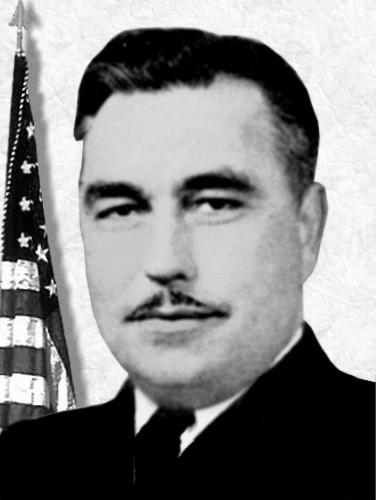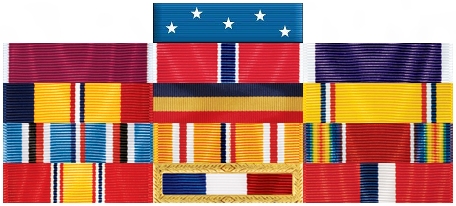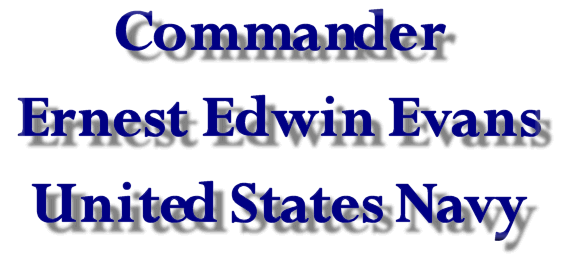Commanding Officer
USS JOHNSTON (DD 557)

U.S. Navy photograph
Commander Ernest E. Evans, U.S. Navy

| Medal of Honor | |
| Legion of Merit | |
| Bronze Star | |
| Purple Heart | |
| Combat Action Ribbon | |
| Presidential Unit Citation | |
| American Defense Service Medal | |
| American Campaign Medal | |
| Asiatic-Pacific Campaign Medal | |
| World War II Victory Medal | |
| National Defense Service Medal | |
| Philippine Presidential Unit Citation | |
| Philippine Liberation Medal | |
| Award Criteria | |
| RANK | DATES | DUTY STATION/EVENT |
| - | 1908 | Born in Pawnee, Oklahoma |
| S1c | 1926 | Recruit Training Command |
| MIDN | 1927-1931 | Student at U.S. Naval Academy Annapolis |
| ENS | 1931-1932 | USS Colorado (BB-45) |
| LTJG | 1931-1933 | USS Roper (DD-147) |
| LT | 1933-1935 | USS Rathburne (DD-113) |
| LT | 1935-1936 | USS Pensacola (CL-24) |
| LT | 1937-1938 | USS Chaumont (AP-5) |
| LT | 1939-1941 | USS Black Hawk (AD-9) |
| LCDR | 1941-1943 | USS Alden (DD-211) |
| CDR | 1943-1944 | USS Johnston (DD 557) |
| CDR | 1944 | Killed in Action at Samar |
| ? | ? | USS Cahokia (YT-135) ? |
Short biography of
Commander Ernest Edwin Evans, U.S. Navy
Ernest Edwin Evans was born in Pawnee, Oklahoma on August 13, 1908. He was three quarters Cherokee Indian. Prior to his Naval Service he attended and graduated from Muskogee Central High School, Muskogee, Oklahoma. He entered the U.S. Navy as an enlisted man on May 29, 1926. The following year he received an appointment to the U.S. Naval Academy in Annapolis, Maryland and graduated with a Bachelor of Science degree in 1931. It is unclear how much time Commander Evans spent at shore commands but his sea duty billets were numerous.
Upon graduation from the Naval Academy Commander Evans began his Naval career at sea aboard the battleship USS Colorado (BB 45) which was part of the U.S. Battle Fleet in the Pacific based in San Diego, California. He then served upon two Pacific Fleet destroyers USS Roper (DD 147) and USS Rathburne (DD 113). In the mid-1930s Commander Evans served on the light cruiser USS Pensacola (CL 24) in the Pacific, also operating out of the homeport of San Diego, California.
By 1937 Commander Evans was transferred to the the transport USS Chaumont (AP 5) in the Far East where he saw service in the waters around China and the Philippines. Before the war, he continued to serve in the same waters in the destroyer tender USS Black Hawk (AD 9).
By the start of the Second World War Commander Evans was serving as Executive Officer aboard the four-piper destroyer USS Alden (DD 211) in the Far East. Before war broke out Alden was on her way to Batavia, Java for supplies and liberty. On December 8, 1941 they were quickly diverted to Singapore where they were to join Admiral Phillips' Royal Navy force formed around HMS Repulse and HMS Prince of Wales (Force Z). Alden arrived in Singapore on the morning of the 11th, two days after the British force had departed. After Force Z was sunk by Japanese aircraft on the 10th Alden swept the area later that day searching for survivors. Alden then returned to Singapore before sailing for a Dutch port in Surabaya, Java. Meeting USS Houston (CA 30) and her escorts in Java the group sailed to Darwin, Australia, arriving on December 28th. Alden was then reassigned to Destroyer Division 58 and spent the next several weeks escorting troop and supply convoys in support of efforts to defend the Malay Barrier. During this period on January 20-21, 1942 Commander Evans would earn a Legion of Merit when his destroyer and Australian warships made at least four depth charge attacks against a Japanese submarine, later determined to be the mine-layer IJN I-124. On February 3, 1942 Alden sailed from Darwin with a convoy bound for Java. In preparations to repulse a Japanese attack near Java, Alden was assigned to the American-British-Dutch-Australian (ABDA) forces where she was heavily engaged with Japanese warships on February 27, 1942 in the Battle of the Java Sea.
On March 14, 1942 Commander Evans assumed command of Alden. Reporting to Commander, Australia-New Zealand area, on March 28th he operated in the waters of the Southwest Pacific until sailing for Pearl Harbor, reaching her destination on June 7th. Following an overhaul at the Mare Island Navy Yard, Alden commenced convoy escort duty between San Francisco and Hawaiian waters on August 11, 1942. Over the next eight months, Commander Evans carried out prosaic escort duty aboard Alden in the Pacific Theater until she departed Mare Island on April 9, 1943 for the Caribbean. Alden spent the next two months shuttling convoys between Trinidad and Guantanamo Bay, before she proceeded north to the New York Navy Yard, which she entered on June 28, 1943 for repairs and alterations. Upon completion of this availability, Commander Evans received orders and was transferred to New Construction duty at a shipyard in Seattle, Washington.
In July 1943 Commander Evans was assigned as the Prospective Commanding Officer of the new Fletcher Class destroyer USS Johnston (DD 557) which was built, launched and commissioned at Seattle-Tacoma Shipbuilding Company in Seattle, Washington on October 27, 1943. Under Evans' command the crew saw their first combat a few months later during the Marshalls Campaign when Johnston bombarded the beaches of Kwajalein on February 1, 1944. In March the ship moved on to the Solomon Islands for more of the same. On May 15, 1944 while performing anti-submarine patrols off Bougainville Commander Evans attacked, depth-charged and sank the Japanese submarine I-16. Evans was awarded the Bronze Star for meritorious achievement in this action. On July 21, 1944 Johnston supported the Pearl Harbor veteran battleship USS Pennsylvania (BB 38) during her bombardment of Guam. By July 29th Johnston had hurled more than 4,000 5-inch shells at the beaches.
By September 1944 Johnston was assigned to Task Unit 32.7.2 of the Western Escort Carrier Task Group 32.7, screening the escort carriers Saginaw Bay, Kalinin Bay, and Petrof Bay for the invasion of the Palau Islands.
During the Battle of Leyte Gulf on October 25, 1944 Commander Evans and Johnston were assigned to Task Unit 77.4.3 AKA Taffy III with 2 other destroyers (Hoel and Heermann), 4 destroyer escorts (Butler, Dennis, Raymond, Roberts) and 6 escort carries (Fanshaw Bay, Saint Lo, Kalinin Bay, White Plains, Kitkun Bay, Gambier Bay). Here, at the Battle Off Samar, they fought the vastly superior Imperial Japanese Navy Centre Force which consisted of 4 battleships, 6 heavy cruisers, 2 light cruisers, and 11 destroyers.
Shortly after 7:00 AM when the Japanese fired upon the American Task Unit Commander Evans gave the order for Johnston to create funnel smoke and he turned his ship towards the swiftly advancing Japanese heavy cruiser line. Scoring several 5-inch gun hits on the lead cruiser he fired all 10 of Johnston's torpedoes and was credited with at least one hit on the first cruiser in line, the IJN heavy cruiser Kumano, effectively placing it out of action. At about 7:30 AM Johnston was hit by 3 14-inch battleship shells which destroyed her bridge. Seriously wounded, Commander Evans moved the Conn to the fantail of the ship where he gave rudder orders through an open hatch for the remainder of the battle. By 7:50 AM, with her speed reduced by the damage and all her torpedoes expended, Johnston supported Hoel, Heermann and Roberts with gunfire support during their torpedo attacks.
As the escort carriers fled southward the escort carrier Gambier Bay became incapacitated by naval gunfire. Around 8:30 AM upon sighting the helpless CVE Commander Evans gave the order for Johnston to fire upon the Japanese warships and draw their fire away from Gambier Bay. Shortly after 9:00 AM Commander Evans placed Johnston between a Japanese destroyer squadron and the escort carriers. Upon firing on the lead destroyer the entire column turned away. Not long after this last engagement Johnston became the focal point of heavy Japanese gunfire and was finally put out of action.
At 9:45 AM Commander Evans ordered his crew to abandon ship. Johnston sank at 10:10 AM, receiving a hand salute from the skipper of a Japanese destroyer. When Johnston sank Commander Evans was seen leaving the ship. He was never found with the group of survivors who spent nearly two days in the water awaiting rescue. He was posthumously awarded the Medal of Honor for his material contribution to the decisive victory won in Leyte Gulf and shared in the Presidential Unit Citation awarded his Task Unit for this action in which he gave his life. Originally he was awarded the Navy Cross for his action at Samar, it was later recalled and replaced by the Medal of Honor.
Commander Evans was survived by his wife and two sons.
In 1955, the destroyer escort USS Evans (DE-1023) was named in his honor.
Source: Robert Jon Cox independent research, USS JOHNSTON-HOEL Association, Dictionary of American Naval Fighting Ships and NavSource.
